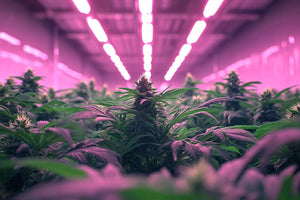
In indoor cannabis cultivation, the light/dark cycle (also known as the photoperiod) is crucial. The first question to consider is: what type of cannabis am I growing? This is because there are two main types of cannabis plants: photoperiod-dependent plants and autoflowering plants. Photoperiod-dependent cannabis plants require a reduction in light exposure to trigger flowering, while autoflowering plants will automatically begin to bloom after 25-30 days, regardless of the light/dark cycle. Below, we will explain how to set up the light/dark cycles for both types of cannabis plants.
Indoor cannabis glow time
How Much Light is Required for Indoor Light-Dependent Plants?
Light Requirements for Light-Dependent Cannabis Plants
For light-dependent cannabis plants grown indoors, they need 18 hours of light and 6 hours of darkness each day during both the initial and vegetative stages. This schedule mimics the long, bright days of summer. Metal Halide (MH) or Agro lamps are suitable during this phase. This phase usually lasts for about 25 to 35 days.
To induce flowering, you must switch to a 12-hour light and 12-hour darkness cycle, replicating the shorter days of autumn. The reduction in light will prompt the plants to begin flowering approximately ten days after the light schedule is changed.
During the flowering period, High-Pressure Sodium (HPS) or Agro plant lights are recommended. One of the main advantages of growing light-dependent cannabis indoors is the ability to control the plant's height and determine the optimal time for flowering by adjusting the light schedule from 18 to 12 hours.
Light Requirements for Indoor Autoflowering Plants
Autoflowering plants grown indoors do not require a change in light hours between the vegetative and flowering stages. These plants need 18 to 20 hours of light per day throughout their entire lifecycle. For healthy growth and sufficient flowering, a standard 18 hours of light and 6 hours of darkness is recommended.
For autoflowering plants, you can use different light spectrums: MH or Agro lamps during the growth stage and HPS or Agro lamps during the flowering stage.
Maintaining Stable Light Cycles in Indoor Cultivation
To maintain a consistent light cycle, it is essential to use an analog or digital timer to automatically turn the lights on and off. Inconsistent light schedules can cause significant issues for plants, including hermaphroditism, developmental delays, and even death. Therefore, it is strongly advised against manually switching the lights on and off.
Timer
How does the light cycle behave during cannabis growth
In summer crops, because we cannot control the time of light, we are completely dependent on the cycle of natural light, which changes with the seasons. There are more and more days after the summer solstice. These days continue until the summer solstice in June. From that moment on, the days began to shorten again.
Therefore, we recommend growing cannabis in early spring, when the mild temperature rise allows the plant to germinate and grow for a few hours. Plants are usually wasted at the beginning of the flowering period in late summer, which is when they think the day begins to shorten and the night to extend.
At the same time, if we plant automatic flowering plants outdoors, we can start planting in spring, and if the latitude and climate permitting, we can even complete 3 cycles. This is because cannabis plants do not need to reduce flowering time. It is understandable that from mid-May to mid-August, the output of self-flowered hemp will reach the best effect, and the daylighting time will reach the maximum at this time.
Note: The above is reprinted from VANQ

